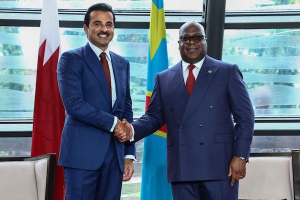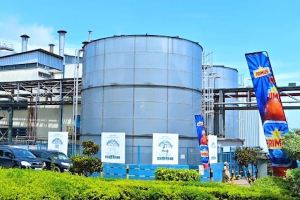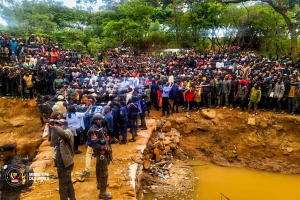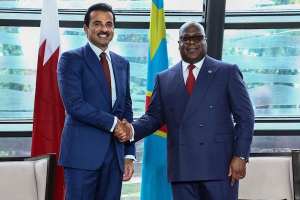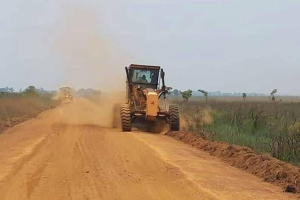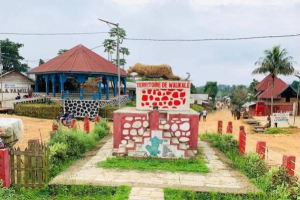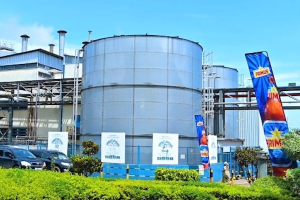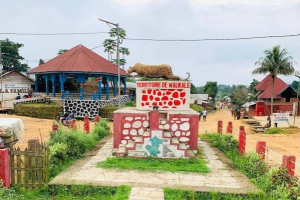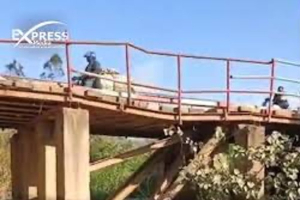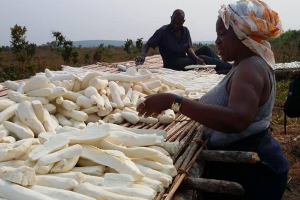Equipe Publication
Qatar deepens ties with the DRC as Emir visits Kinshasa
- Emir Sheikh Tamim’s visit leads to one agreement and five MoUs with the DRC
- Cooperation spans ports, justice, youth, sports, and a social project in South Kivu
- Qatar’s growing footprint includes major investment intentions and involvement in peace efforts
Qatar’s Emir, Sheikh Tamim bin Hamad Al Thani, made an official half-day visit to Kinshasa on November 21, 2025. He was received at N’djili International Airport by President Félix Tshisekedi. The two leaders held a private meeting, the content of which has not yet been disclosed, before witnessing the signing of one agreement and five memorandums of understanding, underscoring their ambition to strengthen bilateral cooperation.
The agreement provides for visa exemptions for holders of diplomatic and special passports in both countries. The five memorandums express each party’s intention to cooperate in economic, legal, diplomatic, social, and sports-related areas.
One memorandum concerns port cooperation between Qatar Ports Management Company (Mwani Qatar) and the National Transport Office (ONATRA SA) for the development and management of Congolese port infrastructure. Two others open the way for closer ties between the two countries’ justice ministries and for cooperation in youth and sports.
The Qatar Fund for Development and the Congolese Ministry of Social Affairs also signed a memorandum to support a multisector emergency project in the South Kivu province. Another document establishes regular political consultations on issues of mutual interest.
On September 2, 2025, Kinshasa hosted the Emir’s cousin, Sheikh Al-Mansour Bin Jabor Bin Jassim Al Thani, head of Al Mansour Holding. During that visit, 18 memorandums of understanding were signed between the Qatari private conglomerate and the DRC. These investment intentions, totaling 21 billion $, cover fifteen sectors, including mining, infrastructure, health, agriculture, and hydrocarbons.
Between Kinshasa and Kigali
For now, cooperation between the DRC and Qatar remains at the stage of intentions for most of the announced projects. However, the scale of these commitments reflects Doha’s ambitions in the country. This interest is also visible in Qatar Airways’ decision, in June 2024, to add Kinshasa to its list of destinations.
It is also known that Ivanhoe Mines announced on September 17, 2025, that it had reached an agreement enabling the Qatar Investment Authority (QIA), Qatar’s sovereign wealth fund, to join its shareholding. In the DRC, Ivanhoe Mines holds 39.6% of Kamoa-Kakula, the country’s largest copper mine, and 62% of the Kipushi zinc mine, recently restarted and poised to enter the global top four. The company is the operator of both strategic sites.
Qatar is also involved in peace efforts in eastern DRC due to its close relations with Rwanda, which supports the AFC/M23 rebels. On the eve of his visit to Kinshasa, the Emir was in Kigali. Sheikh Tamim bin Hamad Al Thani and President Paul Kagame discussed the strengthening of their bilateral relations.
According to Rwandan authorities, trade between Rwanda and Qatar has grown by more than 30% in five years. Doha has also invested in Kigali’s new airport and in the national airline RwandAir.
Heineken sells Bukavu brewery amid loss of control in eastern DRC
Heineken announced that it transferred its Bukavu brewery to Mauritian company Synergy Ventures Holdings Ltd for a symbolic 1 €, after losing operational control of its facilities in eastern Democratic Republic of Congo (DRC). The loss of control is linked to the occupation of the Goma and Bukavu sites by armed groups since June 12, in a context marked by the advance of the M23 in North and South Kivu. (Reuters / Madis Invest)
According to the announcement relayed by Reuters on November 19, 2025, the sale was motivated by humanitarian concerns: preserving jobs and livelihoods, maintaining essential community services, and preventing any misuse of the facilities in an unstable security environment.
It remains unclear how Synergy Ventures plans to restart operations at the Bukavu brewery. The announcement states that the company will assume all responsibilities related to operating the site, including production activities, staff management, and tax obligations. Heineken, for its part, retains a three-year buyback option should security conditions allow a return.
The outlook remains uncertain. Despite the signing on November 15, 2025, in Doha (Qatar), of a Framework Agreement for comprehensive peace in eastern DRC between the Congolese government and AFC/M23 rebels, fighting continues on the ground.
As early as March, Bralima suspended operations in Goma, Bukavu, and Uvira due to raids and looting targeting its warehouses. The rapid deterioration of the situation led to the full evacuation of remaining staff in these three cities on June 20, affecting about one thousand direct and indirect jobs.
These facilities represented a major asset for the group’s Congolese subsidiary. According to internal Bralima data, Goma, Bukavu, and Uvira accounted for nearly one-third of its revenue in the DRC, where Heineken operates five breweries established since the 1920s.
Exploitation artisanale : la tragédie de Kalando réveille le plan de Tshisekedi
Lors d’une réunion de crise à Kolwezi, tenue deux jours après l’accident survenu le 15 novembre 2025 sur le site minier de Kalando, qui a coûté la vie à une quarantaine d’artisans miniers, le ministre des Mines, Louis Watum Kabamba, a fait une annonce inattendue : « Je peux vous dire officiellement aujourd’hui qu’il y a au moins 64 ZEA (zones d’exploitation artisanale) qui ont été dégagées pour vous ». L’identification de ces ZEA constitue le premier point du plan présenté par le président Félix Tshisekedi lors du Conseil des ministres du 13 juin 2025 pour endiguer, « dans les plus brefs délais », les « effets pervers dénoncés dans l’exploitation artisanale » notamment dans la province du Lualaba.
Parmi les problèmes identifiés par le chef de l’État figure l’envahissement des concessions minières industrielles par les exploitants artisanaux, générant des tensions de cohabitation. Le site de Kalando, où l’accident s’est produit, en est l’un des exemples. Situé à 42 kilomètres au sud-est de Kolwezi, il se trouve sur un permis (PE 2116) appartenant à la société Chemical of Africa (Chemaf), qui affirme l’avoir cédé le 21 juillet dernier à Pajeclem Congo Consulting Sarl. Les exploitants artisanaux n’y accèdent que le week-end, grâce à une autorisation « sociale », une situation propice aux tensions.
Le président Tshisekedi avait demandé que les ZEA identifiées soient « susceptibles de rencontrer les attentes du secteur ». On le saura lors de la divulgation des 64 zones. Selon le ministère, elles ont été déterminées à l’issue d’un travail conjoint avec les services spécialisés (SAEMAPE, Cadastre minier, CEEC) et validées après plusieurs missions techniques de terrain.
EGC au cœur du plan
Le ministre Louis Watum Kabamba a indiqué que les arrêtés instaurant ces ZEA ont déjà été signés. Mais, pour l’heure, on ignore quand ces sites seront effectivement mis à disposition ni quand l’exploitation pourra y démarrer. Celle-ci devrait se dérouler en collaboration avec l’Entreprise générale du cobalt (EGC), filiale de la Gécamines, qui détient le monopole du négoce de la production artisanale des substances minérales stratégiques comme le cobalt, l’un des minerais les plus présents dans la région.
L’EGC affirme avoir mis en place un modèle permettant d’aligner le secteur artisanal sur les standards internationaux afin de faciliter la commercialisation de sa production. Ce modèle repose sur le déploiement de « zones minières contrôlées, équipées de dispositifs de pesée, de mécanismes de paiement direct et de systèmes numériques de suivi, garantissant que chaque tonne soit traçable du site artisanal jusqu’à l’usine de transformation ».
Pour permettre à l’EGC d’exercer pleinement son monopole sur le négoce artisanal des minerais stratégiques, le président Tshisekedi a demandé l’application stricte de toutes les règles — y compris les sanctions — contre les usines et entités de traitement qui achètent illégalement du cobalt artisanal en contournant le monopole légal de l’EGC. Il a également appelé la Gécamines et sa filiale à renforcer leur collaboration financière. L’EGC a en effet besoin de financements pour proposer aux mineurs artisanaux des prix compétitifs et des paiements au comptant — comme dans les circuits illégaux — afin de capter une part significative de la production.
Dans le but de séduire les investisseurs, l’EGC a présenté à Kolwezi une première production de 1 000 tonnes de cobalt artisanal, qualifiée de « structurée, éthique et traçable ». Un volume qui montre néanmoins que l’essentiel de la production artisanale demeure en dehors du circuit légal. D’ailleurs, malgré l’accident, l’activité artisanale se poursuit à Kalando « au nom de la paix sociale ».
Pierre Mokoko et Ronsard Luabeya
Lire aussi :
Cobalt artisanal : EGC mise sur 1 000 tonnes « traçables » pour attirer les investisseurs
Guillaume Ngefa s’attaque à l’exploitation minière illégale dans le Lualaba
Cobalt : la part de l’artisanat dans la production de la RDC chute à 2 % en 2024 (rapport)
Avec la visite de l’Émir à Kinshasa, le Qatar confirme ses ambitions en RDC
L’Émir du Qatar, Sheikh Tamim Ben Hamad Al Thani, a effectué ce 21 novembre 2025 une visite officielle d’une demi-journée à Kinshasa, capitale de la République démocratique du Congo (RDC). Il a été accueilli à l’aéroport international de N’djili par le président Félix Tshisekedi. Les deux dirigeants ont ensuite eu un tête-à-tête dont rien n’a pour l’instant filtré. Ils ont par la suite assisté à la signature d’un accord et de cinq protocoles d’entente, signe de la volonté des deux pays de renforcer leur coopération.
L’accord conclu porte sur l’exemption de visas pour les détenteurs de passeports diplomatiques et de passeports spéciaux des deux États. Quant aux protocoles d’entente, ils expriment l’intention des parties de coopérer dans les domaines économique, juridique, diplomatique, social et sportif.
L’un des protocoles concerne la coopération portuaire entre Qatar Ports Management Company (Mwani Qatar) et l’Office national des transports (ONATRA SA) pour le développement et la gestion des infrastructures portuaires congolaises. Deux autres textes ouvrent la voie à un rapprochement entre les ministères de la Justice des deux pays et à une coopération dans les secteurs de la jeunesse et du sport.
Le Qatar Fund for Development et le ministère congolais des Affaires sociales ont également signé un mémorandum d’entente pour soutenir un projet d’urgence multisectoriel dans la province du Sud-Kivu. Un dernier document prévoit l’établissement de consultations politiques régulières sur des questions d’intérêt mutuel.
Le 2 septembre 2025, Kinshasa accueillait déjà le cousin de l’Émir du Qatar, Sheikh Al-Mansour Bin Jabor Bin Jassim Al Thani, dirigeant d’Al Mansour Holding. À cette occasion, 18 protocoles d’accord avaient été signés entre ce conglomérat privé qatari et la RDC. Ces intentions d’investissement, d’un montant total de 21 milliards de dollars, couvrent quinze secteurs, dont l’exploitation minière, les infrastructures, la santé, l’agriculture et les hydrocarbures.
Entre Kinshasa et Kigali
Pour l’heure, la coopération entre la RDC et le Qatar reste au stade des intentions pour la majorité des projets annoncés. Mais l’ampleur des promesses reflète les ambitions de Doha dans le pays. Cet intérêt s’illustre aussi par l’ajout, depuis juin 2024, de Kinshasa parmi les destinations de Qatar Airways.
On sait par ailleurs qu’Ivanhoe Mines a annoncé, le 17 septembre 2025, avoir conclu un accord permettant l’entrée de la Qatar Investment Authority (QIA), le fonds souverain qatari, dans son capital. En RDC, Ivanhoe Mines détient 39,6 % de Kamoa-Kakula, la plus grande mine de cuivre du pays, ainsi que 62 % de la mine de zinc de Kipushi, récemment relancée et en passe d’intégrer le top 4 mondial. La société est également l’opérateur de ces deux sites stratégiques.
Le Qatar est par ailleurs impliqué dans les efforts de paix à l’est de la RDC, en raison de ses bonnes relations avec le Rwanda, soutien des rebelles de l’AFC/M23. La veille de sa visite à Kinshasa, l’Émir était à Kigali. Sheikh Tamim Ben Hamad Al Thani et le président Paul Kagame ont discuté du renforcement de leurs relations bilatérales.
Selon les autorités rwandaises, les échanges commerciaux entre le Rwanda et le Qatar ont augmenté de plus de 30 % en cinq ans. Doha a également investi dans le nouvel aéroport de Kigali et dans la compagnie RwandAir.
Pierre Mukoko et Boaz Kabeya
Lire aussi :
Coopération économique RDC–Rwanda : un accord paraphé, mais le chemin reste long
Mines stratégiques en RDC : le Qatar en passe d’entrer dans le capital d’Ivanhoe
Mines, infrastructures, sécurité : 21 milliards $ d’investissements qataris en vue en RDC
Routes agricoles : la réhabilitation de 280 km lancée dans le Mai-Ndombe
Le Fonds national d’entretien routier (FONER) a lancé, le 20 novembre 2025 à Inongo, chef-lieu de la province de Mai-Ndombe, un programme d’entretien routier portant sur la réhabilitation de 280 kilomètres de routes. Le gouverneur de la province, Lebon Nkoso, a donné le coup d’envoi de ces travaux, qui visent à améliorer la connectivité intérieure et à soutenir les échanges économiques.
Le programme couvre sept des huit territoires de la province : Yumbi, Kiri, Mushie, Kutu, Inongo, Oshwe et Bolobo. Seul Kwamouth en est exclu en raison de l’insécurité persistante.
Plusieurs tronçons prioritaires ont été retenus, dont Bolobo–Ngemu (30 km), Boulevard Ngobila–Yanzalinga (10 km), Banzomoke–Ponde (35 km), Modeo–Nkondi (30 km, territoire de Kiri) et Kutu Panza 3–Itwa (35 km, territoire de Kutu), entre autres.
L’exécution des travaux a été confiée à l’Office des voies de desserte agricole (OVDA) pour une durée de trois mois. Selon le directeur provincial, Deo Gratias Ngontula, une évaluation sera menée chaque mois afin de contrôler l’avancement et la qualité des travaux.
Le gouverneur Lebon Nkoso souligne que ce programme constitue un levier important de développement provincial. Il a appelé à une mise en œuvre rigoureuse afin de faciliter la circulation des biens et des personnes dans cette partie du pays.
Par ailleurs, deux territoires du Mai-Ndombe sont concernés par un autre programme portant sur 103 kilomètres de routes agricoles convergeant vers les principaux bassins de production, identifié en juillet dernier par le Fonds social de la République. Leur réhabilitation, également confiée à l’OVDA dans le cadre du Projet d’appui au développement des chaînes de valeur, inclut la construction de quatre ponts ainsi que trois petites infrastructures portuaires, dont deux à Inongo et une à Bokoro.
Ronsard Luabeya
Lire aussi :
Projet Guma : premiers équipements expédiés en RDC, mais des zones d’ombre persistent
Entretien de routes agricoles : le PNDA vise 707 km au Kasaï Central
Kongo central : la réhabilitation de 550 km de routes de desserte agricole lancé
North Kivu: Critical RN3 Condition Disrupts Walikale Supply Chain
- Nearly 180 trucks from Kisangani remain immobilized on the Makana–Mengwe section of RN3.
- Local markets in Walikale report rising prices and declining stocks of essential goods.
- Transporters urge provincial and national authorities to launch emergency rehabilitation works.
The Walikale territory in North Kivu faces a growing risk of supply shortages in essential goods. The advanced degradation of National Road No. 3 (RN3), which links the region to Maniema, has disrupted the circulation of goods for nearly a month.
Local sources report that almost 180 trucks from Kisangani remain immobilized on the Makana–Mengwe section, located on the border between Walikale (North Kivu) and Lubutu (Maniema). Heavy rains have turned several portions of the road into deep mud, which makes vehicle passage nearly impossible.
The Association des Chauffeurs du Congo (ACCO), quoted by Actualité.cd, states that 120 vehicles remain blocked between Makana and Makote in Walikale territory. ACCO adds that 80 additional trucks remain bogged down between Losso and Mengwe on the Maniema side.
This situation significantly slows traffic along a corridor that remains essential for supplying remote areas of North Kivu.
The disruption already affects several consumption centers, including Makana, Biruwe, Logu, Ndjingala, Mubi and central Walikale. Local traders report rising prices for basic commodities and gradually declining inventory levels due to irregular resupply. Some imported products from Kisangani have begun to disappear from local markets.
In response to the prolonged paralysis, transporters call on provincial and national authorities to launch urgent rehabilitation works on the affected road segments. They argue that a rapid intervention would restore traffic and prevent a broader supply crisis in the region.
This article was initially published in French by Ronsard Luabeya
Adapted in English by Ange Jason Quenum
Face au conflit à l’est de la RDC, Heineken cède sa brasserie de Bukavu à Synergy Ventures
Heineken a annoncé avoir transféré sa brasserie de Bukavu à la société mauricienne Synergy Ventures Holdings Ltd pour un euro symbolique, après avoir perdu le contrôle opérationnel de ses installations dans l’Est de la République démocratique du Congo (RDC). Cette perte de contrôle est liée à l’occupation des sites de Goma et de Bukavu par des groupes armés présents depuis le 12 juin, dans un contexte marqué par la progression du M23 dans les provinces du Nord-Kivu et du Sud-Kivu.
Selon l’annonce relayée le 19 novembre 2025 par Reuters, la cession est motivée par des considérations humanitaires : préserver les emplois et les moyens de subsistance, maintenir les services communautaires essentiels et prévenir toute utilisation abusive des installations dans un environnement sécuritaire instable.
On ignore encore comment Synergy Ventures compte relancer les activités de la brasserie de Bukavu. Selon l’annonce, l’entreprise reprendra toutefois l’ensemble des responsabilités liées à l’exploitation du site, notamment les opérations de production, la gestion du personnel et les obligations fiscales. Heineken conserve, de son côté, une option de rachat valable trois ans, dans l’hypothèse où les conditions sécuritaires permettraient une reprise.
Une perspective incertaine. Malgré la signature, le 15 novembre 2025 à Doha (Qatar), d’un Accord-cadre pour une paix globale dans l’Est de la RDC entre le gouvernement congolais et les rebelles de l’AFC/M23, les combats se poursuivent sur le terrain.
Dès le mois de mars, Bralima avait suspendu ses opérations à Goma, Bukavu et Uvira en raison de raids et de pillages visant ses entrepôts. La dégradation rapide de la situation avait conduit, le 20 juin, à l’évacuation complète du personnel encore présent dans ces trois villes, soit environ un millier d’emplois directs et indirects affectés.
Ces installations représentaient pourtant un enjeu majeur pour la filiale congolaise du groupe : selon les données internes de Bralima, Goma, Bukavu et Uvira généraient près d’un tiers de ses revenus en RDC, où Heineken exploite cinq brasseries implantées depuis les années 1920.
Boaz Kabeya
Lire aussi :
Heineken évacue Goma et Bukavu, un tiers de ses revenus en RDC affecté
Nord-Kivu: l’état critique de la RN3 perturbe l’approvisionnement de Walikale
Le territoire de Walikale, dans la province du Nord-Kivu, fait face à un risque de rupture d’approvisionnement en produits de première nécessité. Depuis près d’un mois, la dégradation avancée de la route nationale n°3 (RN3), principal axe reliant la région au Maniema, paralyse la circulation des marchandises.
Selon des sources locales, près de 180 camions en provenance de Kisangani sont immobilisés sur le tronçon Makana–Mengwe, à la limite des territoires de Walikale (Nord-Kivu) et Lubutu (Maniema). Les pluies diluviennes ont transformé plusieurs portions de la route en bourbiers, rendant le passage des véhicules presque impossible.
L’Association des chauffeurs du Congo (ACCO), citée par Actualité.cd, indique par ailleurs que 120 véhicules sont bloqués entre Makana et Makote, dans le territoire de Walikale, tandis que 80 autres sont embourbés entre Losso et Mengwe, côté Maniema. Cette situation provoque un ralentissement significatif du trafic sur un corridor vital pour l’approvisionnement des zones enclavées du Nord-Kivu.
Les conséquences se font déjà sentir dans plusieurs centres de consommation, notamment Makana, Biruwe, Logu, Ndjingala, Mubi et Walikale-centre. Les commerçants signalent une hausse des prix des denrées de base et une baisse progressive des stocks, faute de réapprovisionnement régulier. Certains produits importés depuis Kisangani commencent à se raréfier sur les marchés locaux.
Face à cette paralysie, les transporteurs appellent les autorités provinciales et nationales à engager en urgence des travaux de réhabilitation sur ce tronçon. Ils estiment qu’une intervention rapide permettrait non seulement de rétablir le trafic, mais aussi d’éviter une crise d’approvisionnement.
Ronsard Luabeya
Lire aussi :
Ituri : l’effondrement d’un pont perturbe les échanges avec l’Ouganda
Ituri : l’effondrement d’un pont perturbe les échanges avec l’Ouganda
Le pont Mbogu, situé à environ 9 km de Bunia dans le groupement Babiase, s’est effondré le 18 novembre 2025 lors du passage d’un camion en provenance de Kasenyi. Cet incident a interrompu la circulation sur l’un des axes les plus fréquentés de l’Ituri.
L’axe Bunia–Kasenyi joue un rôle essentiel dans l’acheminement des marchandises en provenance de l’Ouganda, notamment via le lac Albert. Ce corridor assure une part importante des flux commerciaux entrant dans la ville de Bunia.
Selon la presse locale, des centaines de camions transportant des produits ougandais, dont certains périssables, sont désormais bloqués, entraînant des retards dans la chaîne d’approvisionnement.
Le pont Mbogu avait déjà cédé en mai 2025 après un débordement dû aux fortes pluies. L’incident actuel survient quelques mois après des interventions provisoires qui n’avaient pas permis de stabiliser durablement l’ouvrage, resté vulnérable aux charges lourdes et aux intempéries.
L’Association des transporteurs et chargeurs du Congo (ATCC) appelle à une intervention urgente afin de rétablir la circulation sur cet axe et d’éviter une accumulation prolongée de marchandises à la frontière.
Boaz Kabeya
Lire aussi :
Blocage des camions sur la route Bunia–Mahagi : Bunia redoute une flambée des prix
Bassin du Congo : 93 millions $ mobilisés pour des projets sans déforestation
À Belém, au Brésil, les gouvernements d’Allemagne, de Belgique et de Norvège, ainsi que l’Initiative pour la forêt d’Afrique centrale (CAFI), ont annoncé le 17 novembre 2025, en marge de la COP 30, un engagement collectif de 93 millions de dollars au profit de Canopy Trust. Ce mécanisme financier, lancé début 2025 par la Catalytic Finance Foundation, une fondation basée en Suisse, vise à promouvoir l’investissement privé dans des chaînes de valeur durables et sans déforestation dans le Bassin du Congo.
Le principe est d’utiliser des fonds publics pour réduire le risque lié aux projets et les rendre plus attractifs pour les investisseurs privés. Les 93 millions engagés serviront de capital-risque : en cas d’échec des projets financés, ce sont les bailleurs publics qui absorberont les premières pertes, avant les investisseurs privés. Grâce à ce mécanisme — qui inclut également une assistance technique — les promoteurs ambitionnent d’attirer au moins 500 millions de dollars d’investissements privés dans des chaînes de valeur durables en Afrique centrale d’ici 2035.
Pour permettre à la République démocratique du Congo (RDC), qui abrite environ 60 % des forêts du Bassin du Congo, de tirer pleinement parti de cette initiative, la ministre de l’Environnement, du Développement durable et de la Nouvelle économie climatique, Marie Nyange Ndambo, a promis d’accélérer les réformes visant à améliorer le climat des affaires. « Nous sommes résolus à accélérer les réformes destinées à améliorer le climat des affaires, afin que les investisseurs puissent s’associer à nous en toute confiance et contribuer à une croissance durable à grande échelle », a-t-elle déclaré.
En RDC, quatre projets pilotes ont déjà été identifiés pour bénéficier d’une assistance technique et d’un financement initial. Ils sont concentrés dans la région de Bankana, à 115 kilomètres à l’est de Kinshasa, et combinent la production de charbon de bois et la transformation de farine de manioc dans un modèle intégré reliant les chaînes de valeur agricoles et énergétiques.
Accroître les revenus
Selon Canopy Trust, ces initiatives visent à développer un système agroforestier reposant sur de petites exploitations agricoles, et à renforcer les chaînes de valeur forestières et agricoles, afin de permettre aux communautés locales d’augmenter leurs revenus et d’améliorer leur sécurité alimentaire et énergétique.
L’étude de faisabilité menée par Canopy Trust souligne que la RDC est confrontée à une déforestation élevée due à la culture itinérante sur brûlis et à la production non durable de charbon de bois. Ces pratiques entraînent chaque année la perte d’environ 0,5 million d’hectares de forêts primaires et 0,8 million d’hectares de forêts secondaires et zones boisées. La production de manioc, qui représente 72 % de la production agricole primaire du pays, repose presque entièrement sur la culture sur brûlis, contribuant fortement à la déforestation et aux émissions de gaz à effet de serre, estimées à 629 millions de tonnes équivalent CO₂ en 2021, selon les données de Canopy Trust.
Les projets soutenus visent à atténuer ces impacts environnementaux en utilisant du bois d’acacia issu de plantations plutôt que du bois de forêt naturelle, et en améliorant l’efficacité des fours à charbon de bois, ce qui permettrait de réduire les émissions de 90 % par rapport aux méthodes traditionnelles. Pour la production de manioc, les approches proposées pourraient augmenter les rendements jusqu’à 300 %, contribuant à l’autonomisation des petits exploitants et à la création d’emplois dans les unités de transformation intégrées, tout en garantissant un débouché stable pour leurs produits.
Boaz Kabeya
Lire aussi :
Est de la RDC : 19 millions $ pour soutenir la résilience agricole face au changement climatique
Déforestation : la RDC a perdu 590 000 ha de forêts primaires en 2024 (GFW)
Biogaz : la stratégie de la RDC pour produire 1,5 milliard de Nm³ d’ici 2030
Gaz domestique : 1,2 million de ménages ciblés à Kinshasa d’ici 2030
Charbon de bois : enjeux autour d’un business estimé à 4 milliards $ par an en RDC





